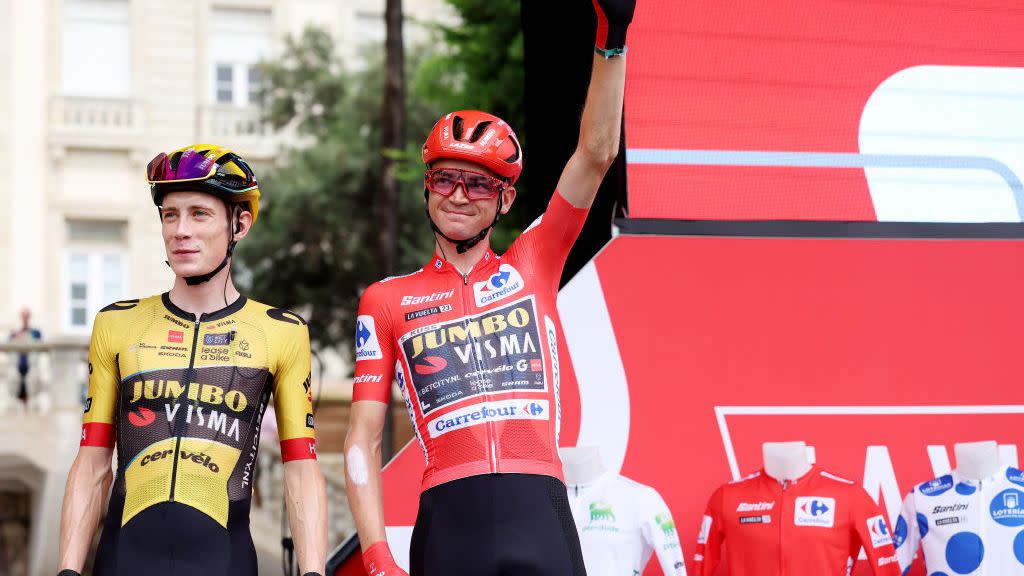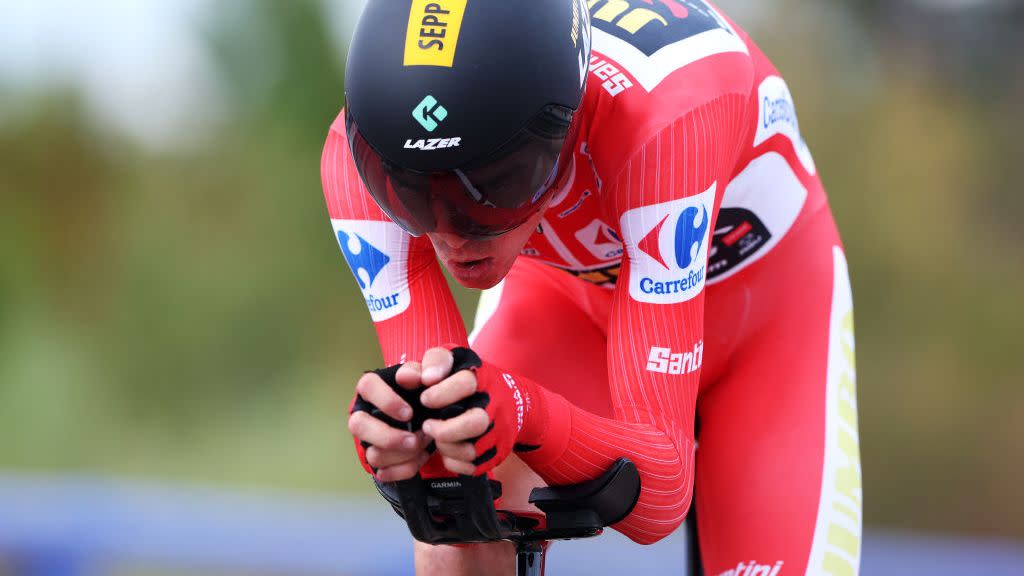Sepp Kuss Could Win the 2023 Vuelta a España — And It’s a Really Big Deal

The 2023 Vuelta a España is heading toward an exciting finish, with an American on the verge of winning the race overall and his team about to make history–twice. Here’s a quick rundown of what went down since the first rest day–and what to expect in the Spanish grand tour’s difficult final week:
Who’s Winning?
With just six stages left in the season’s final grand tour, American Sepp Kuss (Jumbo-Visma) still wears the red jersey as the Vuelta’s overall leader. The first male American to lead a grand tour in a decade, Kuss jumped up the General Classification after winning Stage 6 from a breakaway, then took the jersey for himself after finishing with the leading group on Stage 8.
His biggest test came on Stage 10, the Vuelta’s only individual time trial. But Kuss–who turns 29 on Wednesday–did well to defend his lead, losing some time to his rivals, but not enough to threaten his place atop the GC.

His chances are helped by the fact that the riders in second- and third-place overall are two of his Jumbo-Visma teammates: Slovenia’s Primož Roglič at 1:37 and Denmark’s Jonas Vingegaard at 1:44. If the team rides as well as it has during the first two weeks–and Kuss avoids having a bad day on one of the several mountain stages left in this year’s race–he should bring home the first American grand tour victory since Chris Horner won the Vuelta in 2013.
As far as the Vuelta’s other competitions are concerned, Australia’s Kaden Groves (Alpecin-Deceuninck) heads into the race’s final week wearing the green jersey as the leader of the Vuetla’s Points Classification; and Belgium’s Remco Evenepoel–whose own GC hopes disappeared after the defending champion lost 27 minutes on Stage 13–wears the polka dot jersey as the leader of the Vuelta’s King of the Mountain’s Classification. Spain’s Juan Ayuso (UAE Team Emirates)–the first non-Jumbo rider on the General Classification–wears the white jersey as the Vuelta’s current Best Young Rider.
What Happened
The Vuelta’s second week began with the race’s only individual time trial, a 25.8km race against the clock in Valladolid. Italy’s Filippo Ganna (INEOS Grenadiers) won the stage (somewhat salvaging his team’s terrible race so far) and Evenepoel finished second, gaining a little bit of time on the rest of the GC favorites. Kuss–who entered the week with a cushion of more than two minutes–rode admirably, losing time to Evenepoel, Roglič, Ayuso, and Vingegaard–but not enough to end his hopes of winning the race overall.
Stage 11 brought the first summit finish of the second week and a breakaway went up the road and built itself a large advantage. Spain’s Jesús Herrada (Cofidis) took the stage win atop La Laguna Negra, while the GC favorites all finished together more than 5 minutes later. Stage 12 ended with a field sprint, with Argentina’s Juan Sebastián Molano getting the better of Groves in Zaragoza, while the race favorites finished safely in the bunch, anticipating a showdown on Stage 13.
And for good reason: Stage 13 featured four huge Pyrenean ascents crammed into just 134.7km, with a summit finish on the infamous Col du Tourmalet, perhaps the most famous climb in the Pyrenees.
In the end it proved to be a day to forget for Evenepoel, who was dropped on the Col d'Aubisque before the midway point of the stage and saw his hopes of defending his 2022 title go up in smoke. The Belgian lost 27:05 on the day, plummeting down the Vuelta’s General Classification.
Up the road, it turned out to be another dominant day for Jumbo-Visma, with Vingegaard winning the stage and Kuss and Roglič finishing second and third to add to the American’s—and the team’s—overall advantage. Ayuso led home the remaining favorites to finish fourth just five seconds after Roglič, but that damage was done: Jumbo’s three favorites now occupied the top-3 spots overall, giving the team a numerical and strategic advantage that should prove tough to overcome.
The weekend brought no changes at the top of the GC. Evenepoel rebounded to win Stage 14 with an assertive ride from a breakaway. The Belgian then went up the road again on Sunday, but was bettered by Portugal’s Rui Costa (Intermarché-Circus-Wanty), who outsprinted Colombia’s Santiago Buitrago (Bahrain-Victorious) and Germany’s Lennard Kämna in Lekunberri to bring the Vuelta’s second week to an exciting close. Behind the break, UAE Team Emirates did its best to break Jumbo’s stranglehold on the chasing peloton, but to no avail.
What Did We Learn?
The 2023 Vuelta a España will now be remembered as either the greatest performance–or the greatest collapse–by a single team in the history of men’s professional cycling. No team has ever swept three grand tours in a season and no team has ever swept all three spots on a grand tour’s final podium–and now Jumbo-Visma is poised to accomplish both feats at this year’s Vuelta. At this point, only a fast-moving stomach virus could derail their plans.
For Kuss, there aren’t many chances for one of his teammates to overtake him—not that they would try. Stage 17’s summit finish atop the Angliru stands out as the only day that could throw a wrench in his plans (and it just so happens to be his birthday).
A 12.5km ascent with a 10 percent average gradient–and pitches that hit 24 percent—the Angliru is the hardest single climb in the entire Vuelta. There’s really nowhere to hide on the Angliru’s steep upper slopes, and teamwork often goes out the window. If Kuss shows any signs of weakness, Roglič and Vingegaard will have no choice but to leave him behind for the sake of the team’s overall goals.
But Kuss has already proven himself to be one of the best climber’s in the race and he says he’s getting stronger each week. So there’s little reason to suspect he won’t handle himself just fine–especially with no one seemingly able to challenge the American or his team. Ayuso might give it a go in the hopes of overtaking one of the team’s captains to claw his way onto the final podium, but at 53 seconds behind Vingegaard, that’s a longshot.
What’s Next?
The third week begins with Stage 16, a mainly flat stage that starts along the coast but ends with a summit finish on the Category 2 climb to La Hermida, a 5km climb with ramps that hit 14 percent. Stage 17 rivals Stage 13 as the 2023 Vuelta’s hardest. A 122.6km stage with three categorized climbs–including a summit finish on the “Beyond Category” Altu de l’Angliru–it’s the focal point of the final week.
Stage 18 brings even more climbing, with five categorized ascents including a summit finish on the Category 1 La Cruz de Linares. The day after a finish atop the Angliru, this should be a day for a breakaway filled with out-of-contention GC riders to go up the road in the hopes of winning the stage–while the Vuelta’s few remaining GC contenders save themselves for the final climb, perhaps several minutes later. Any sprinters who have survived the last two weeks will appreciate Stage 19: it’s one of the flattest in this year’s Vuelta.
And if the Vuelta hasn’t been decided yet, Stage 20 will settle things once and for all with a 208km stage (the longest in this year’s race) with ten categorized climbs (that’s not a typo) through the Guadarrama Mountains outside of Madrid. The climbs are all Category 3 ascents, but they add up to over 4,000meters of elevation gain, which means Stage 20 should bring the fight to win the 2023 Vuelta a España to a dramatic conclusion–just before Stage 21 officially brings the race to a close in Madrid with a flat stage that will give the Vuelta’s remaining field sprinters one last chance to shine.
You Might Also Like
